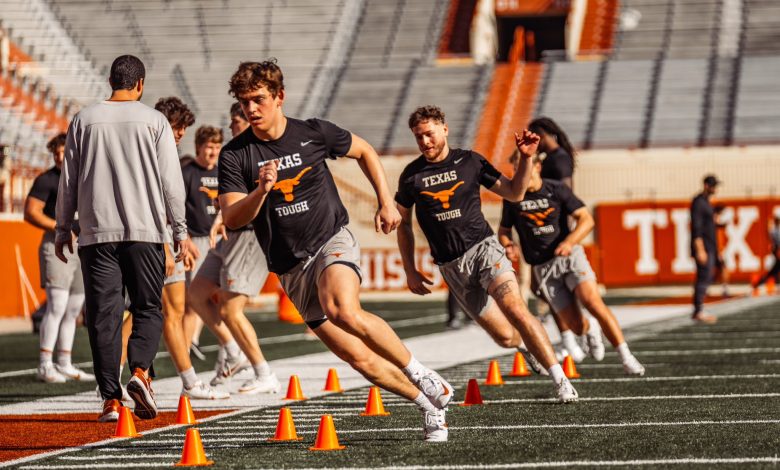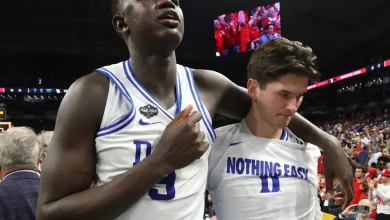Winter football practices for the Texas Longhorns begin.

Winter Football Practices for the Texas Longhorns Begin: Building for the Future
As the temperature drops and the days grow shorter, the beginning of winter marks an important chapter for the Texas Longhorns football team. While the rest of the college football world begins to shift its focus toward offseason activities, the Longhorns take the field for their winter practices, a crucial time for development, strengthening, and laying the foundation for the upcoming season. These practices, which begin in earnest after the conclusion of bowl season, are more than just about physical preparation—they’re about building unity, refining skills, and setting the tone for the future.
With the Longhorns coming off a promising season, the focus on winter practice is especially critical as they look ahead to 2025 and beyond. Under head coach Steve Sarkisian, who is entering his fourth year at the helm, winter practices are an opportunity for players to sharpen their abilities, work on their weaknesses, and bond as a team. It’s a time to focus on details—whether it’s a new playbook or an individual’s technical development—and also to build the mental toughness that will be needed for the grind of the 2025 season.
This article takes a closer look at the significance of winter football practices for the Texas Longhorns, how they set the stage for success, and what fans can expect as the team prepares for another competitive season.
Why Winter Practices Matter
Winter practices serve as the foundation for every team’s preparation for the upcoming season. Unlike spring practices, which often feature full-team scrimmages and heavy game simulations, winter practices are more focused on development, strength, and conditioning. They are often seen as the first opportunity to build momentum after the fall season, giving players time to refresh, learn, and fine-tune their skills before the full swing of spring training.
For the Texas Longhorns, winter practices have become a crucial part of their program, especially under Sarkisian’s leadership. These sessions provide an opportunity for players to focus on individual technique, improve their conditioning, and get a head start on the playbook for the next season. Winter workouts also offer a chance for new recruits to get a feel for the program and to begin integrating into the culture of Texas football.
Moreover, winter practices are critical for building team chemistry. With new players arriving, especially after the early signing period and through the transfer portal, it’s vital that the team establishes strong relationships early on. These early bonding moments and practices are important as the team gears up for a long and challenging season ahead. A cohesive unit, where players trust and understand each other, can make a huge difference in the heat of battle.
Focusing on Strength and Conditioning
One of the primary objectives of winter football practices is improving strength and conditioning. For players, this period offers an opportunity to focus on physical fitness in ways that may not be possible during the regular season. Texas’ strength and conditioning program is known for being one of the best in the nation, and under **Coach David (formerly of Alabama), it’s expected that the players will go through grueling, comprehensive workouts aimed at pushing them to their physical limits.
In winter, the emphasis is often on building explosiveness, speed, and strength—qualities essential to succeeding in the physical nature of Big 12 football. Players work on improving their size, strength, and endurance so that they can handle the demanding nature of college football, where every game is a physical test. Whether it’s lifting weights, running drills, or agility exercises, the Longhorns’ training staff leaves no stone unturned in ensuring that the team is prepared for the rigorous season ahead.
Offensive linemen work on increasing power and footwork, while defensive players focus on their flexibility, speed, and strength to shed blockers and make tackles. Quarterbacks, meanwhile, work on their arm strength and conditioning, while also fine-tuning their footwork for a more efficient throwing motion. This attention to detail in all areas of strength and conditioning makes the winter practices a valuable part of Texas’ preparation process.
For younger players and incoming recruits, winter practices also help them get up to speed with the expectations of college football. Adjusting to the strength requirements of the sport is one of the most difficult transitions for freshman players, and winter workouts provide an excellent opportunity to make those adjustments before the full intensity of spring and fall practices take over.
Position-Specific Development
In addition to physical conditioning, winter practices are also a time for position-specific development. During these practices, coaches place an emphasis on the finer details of their positions. For instance, defensive backs may work on their coverage skills and reaction times, while wide receivers focus on improving their route running and hand-eye coordination.
Quarterbacks, with a potentially more significant responsibility in the 2025 offense, will get extra attention from Sarkisian, who is known for his work with quarterbacks. For Quinn Ewers, the team’s starting quarterback, winter practices are an opportunity to work on his decision-making, footwork, and timing with his receivers. With the potential loss of Bijan Robinson to the NFL, the Longhorns’ offense will need to be versatile, and much of that versatility will start with the quarterback position. Ewers will have the chance to get comfortable with new offensive schemes and hone his leadership skills, becoming a more complete player as the season approaches.
Running backs, too, are a key focus during winter workouts. Texas will need a strong running game in 2025 to keep the offense balanced, and the running backs will have to build the strength, vision, and explosiveness necessary to step up in the absence of a generational talent like Robinson. New recruits or young players such as Jaydon Blue will use winter practices to show they can be the next great back in the Texas program. Running backs coach Tashard Choice will work with the team on improving ball security, blocking skills, and maintaining speed in the open field.
On the defensive side of the ball, winter practices will focus on getting the defensive line and linebackers prepared for a competitive schedule. The defense will look to improve their ability to stop the run and get pressure on opposing quarterbacks. With players like Jaylan Ford and Barrett Carter returning, winter practice will allow them to build upon their successes from last season and refine their techniques. The secondary will also look to develop tighter coverage and improve turnover rates, crucial to Texas’ efforts in 2025.
Implementing New Plays and Schemes
Winter practice is a time when coaches can begin implementing new plays and schemes. The Longhorns’ coaching staff will focus on introducing offensive and defensive concepts for the 2025 season, using this time to review and refine last year’s strategies. This includes analyzing what worked well, what didn’t, and what changes need to be made moving forward.
On offense, Sarkisian is known for his innovative play calling and his ability to develop sophisticated, fast-paced systems that take advantage of the opposing defense’s weaknesses. As the team moves into 2025, the offensive playbook may see some changes as the coaching staff tweaks and refines its strategy based on player strengths. This is especially important given that Texas will likely have new faces in key roles, and having a versatile, adaptable offensive system will be key to their success.
Defensively, Texas will need to focus on stopping the explosive offenses in the Big 12 while also remaining disciplined against power-running teams. Coordinators like Pete Kwiatkowski will work to solidify defensive fronts and coverage schemes, while also creating new ways to generate pressure on opposing quarterbacks.
Winter practice gives coaches the opportunity to experiment with these plays in a non-competitive environment. There are no game pressures, no rivalries, and no external distractions—just the focus on player development and executing new schemes to prepare for the challenges of the upcoming season.
Building Mental Toughness and Leadership
While physical preparation is undoubtedly important, winter practices also focus on building the mental toughness that is needed for success on the field. For players who were part of a team that came close to a College Football Playoff appearance in 2024, overcoming the mental hurdle of pushing through adversity is key to continued growth.
Leadership development is another aspect of winter practice that is often overlooked. Young players need to learn how to become leaders on and off the field. The ability to step up and provide leadership, both vocally and by example, is crucial for the success of the team. Winter practice provides the opportunity for the team’s veterans, such as Jatavion Sanders, Keondre Coburn, and Deshaun Jamison, to help mold the younger players into leaders and contributors. These leadership qualities will be vital when the team faces tough matchups during the season.









